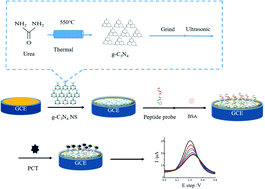Construction of a non-enzymatic electrochemical sensor based on graphitic carbon nitride nanosheets for sensitive detection of procalcitonin†
Abstract
In this study, we established a label free and ultrasensitive electrochemical sensor based on graphitic nitride nanosheets (g-C3N4 NS) for procalcitonin (PCT) detection. Firstly, an easy-to-prepare and well-conducting g-C3N4 NS was synthesized. Next the g-C3N4 NS was immobilized on the electrode surface by π–π stacking, and further used to anchor the specific recognition peptide (PP). The surface morphology and structure after g-C3N4 NS and PP modification was characterized by X-ray photoelectron spectroscopy (XPS), atomic force microscopy (AFM) and electrochemistry. The sensing property of this sensor was evaluated by differential pulse voltammetry (DPV) and showed a detection sensitivity with a dynamic range from 0.15 to 11.7 fg mL−1 with a low limit of detection (LOD) of 0.11 fg mL−1. Besides, the electrochemical biosensor was successfully used to detect PCT in human serum samples, and the results suggest its potential use in clinical application.



 Please wait while we load your content...
Please wait while we load your content...